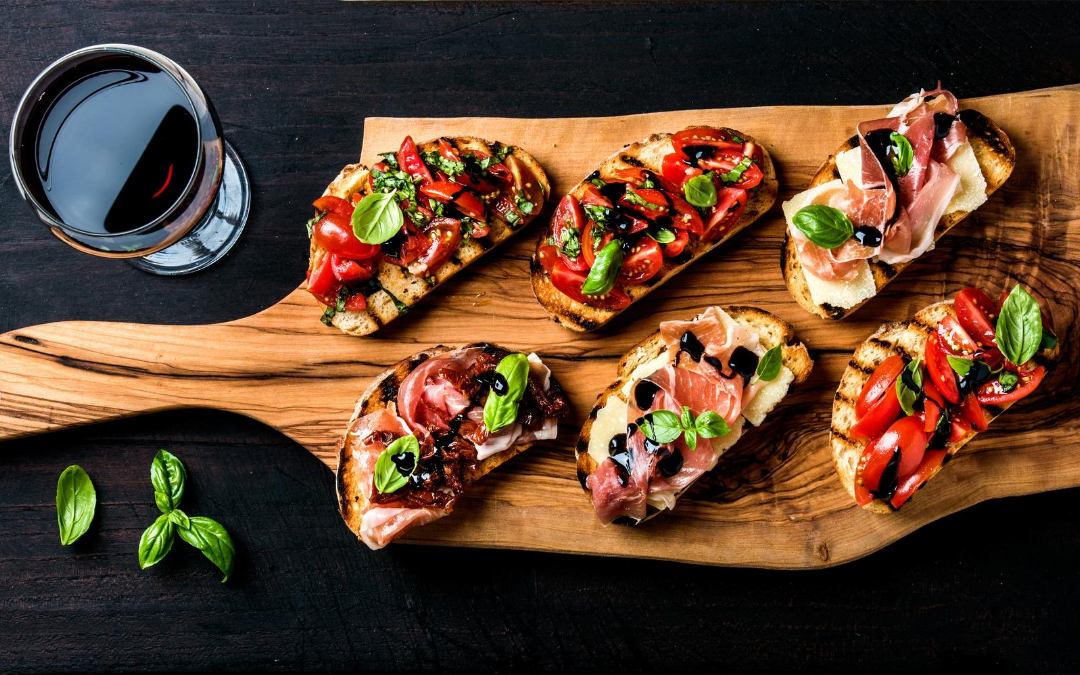Appetizers are meant to stimulate your appetite and leave you wanting more. This course can set the tone for the whole meal and is an easy way to elevate an otherwise uninspiring entrée and add pizzazz to your next dinner party. In this blog we will explain a bit more about why appetizers are a great way to start your next meal.
History of appetizers
There are various thoughts as to exactly when and why appetizers became a society norm; however, most scholars believe that the act of having a small portion of food before your main meal has been around since human’s transitioned away from being hunter-gatherers and had more plentiful access to food. It has been recorded that the Athenians served buffets of tiny foods like cockles, sea urchins, and other delicacies before their main meals. In addition, around the first century A.D., wealthier upper-class citizens were depicted as indulging in “multi-course leisurely meals” where the first course was often fruit, eggs, cheeses, olives, fish or vegetables.
Fast forward to the end of the 1800s and appetizers were more commonly served after the main meal, and before the dessert course. This may seem odd today; however, the appetizer course at that time was meant to be a type of refresher before the sweet ending to the meal. This eventually changed sometime in the 1900s to be served before the start of the meal.
What kind of tiny food is this?
There is a wide array of terminology used for the tiny foods that precede the main meal, which may differ based on function, means of eating, and geographical location. The British commonly refer to the first course simply as the ‘starter’ whereas, in North America, this course is an ‘appetizer’. To ensure that you know your Canape from your Crudités, we have included a list of tiny foods and their descriptions below.
Appetizer – quite literally means something to whet the appetite or to appease. In North America, the appetizer is the first course of a meal and is ideally created to harmonize with the next course. By definition, an appetizer doesn’t need to be a tiny food and is generally eaten with cutlery while sitting down at the table.
Hors d’oeuvres – are typically eaten in one or two bites and served at cocktail parties where a variety of hors d’oeuvres are offered. Guests should be able to comfortably eat while standing and mingling.
Amuse-Bouche –– is an impeccably presented, single bite of food which is designed by the chef as a complimentary teaser for what is to be offered next. An amuse-bouche usually cannot be ordered and is not available on a menu as is at the discretion of the chef.
Canapes – are savoury toppings, served on a cracker, pastry or bread base and meant to be eaten in one or two bites.
Crudités – are thinly sliced raw vegetables meant to be dipped into an accompanying sauce and eaten in one bite.
Aperitifs – is an alcoholic beverage served before the meal and meant to stimulate your appetite. It is usually dry, such as champagne, wine, gin or vermouth.
Internationally, appetizers have many different names although they all describe a type of tiny food:
Tapas – Spain
Zensai – Japan
Cicchetti – Italy
Zakuski – Russia
Antipasto – Italy
Tiny foods can be an exciting way to showcase your culinary tastes and styles while using kitchen and restaurant supplies that you would normally use for other purposes. Consider experimenting with the presentation of your appetizers and using items like cheese boards or cocktail glasses to set the mood for your meal.
How can I make appetizers more interesting?
Appetizers should set the culinary stage for the following courses and encourage conversation among dinner guests. There is a wide range of kitchen and restaurant supplies that can elevate any humdrum table. Try adding some Flamingo Plastic Swords to differentiate the appetizers or to add some fun to the appetizers for the dinner party.
The benefit of appetizers
There are many benefits associated with appetizers including:
- Appetizers can help you stick to your diet and eat less.
- Ordering two or three appetizers in a restaurant, rather than a single entrée, allows for a variety of food options, taste and flavours.
- Appetizers have the ability to bring people together. There are many sharable options and they are meant to be enjoyed while chatting with dinner guests.
At Unique Restaurant Supplies, we have a wide range of small appliances, tableware and disposable products which will help every home chef reach new heights in their culinary creations. Have a look through our convenient online store and browse through the available products today.


